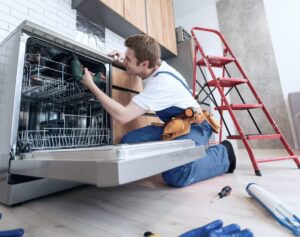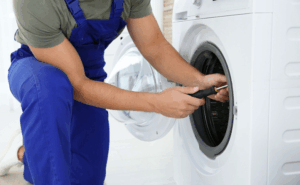You spot a puddle. You worry it will warp the floor. Before panic sets in, breathe. A few quick checks can help right away. In fact, many leaks start small and grow only when they are ignored. Today, this blog will guide you through simple steps that you can try safely. If done soon, they often stop the mess. And yes, we’ll make it easy. We’ll also share when to call a pro. Let’s start with what a refrigerator leaking water really tells you.
What Does a Refrigerator Leaking Water Mean Right Now?
Leaks typically indicate one of three issues: blocked drains, loose connections, or faulty seals. First, look for obvious drips under the front edge. Then, peek behind the kick plate for pooled water. Next, check the back panel for damp spots. A quick refrigerator water leak fix often starts with cleaning the drain and leveling the feet. If the cabinet rocks, adjust the front legs so the doors close firmly. Because doors seal better when the unit is slightly tilted back, a minor tweak can help.
However, you also want simple refrigerator maintenance tips. Wipe door gaskets clean with warm soapy water. Clear crumbs from the drain hole with a soft brush. Vacuum dust from the front grille. As a result, air flows better and frost doesn’t build up as fast. Finally, keep a short leak log. Note when it happens and where you see moisture. Therefore, you can track patterns and narrow the cause.
1) Check the Door Seals and Leveling
Bad gaskets let warm air in. Then, extra moisture becomes water. Because of that, you might see beads along the frame. Gently close a sheet of paper in the door. If it slips out easily, the seal may be weak in that area. Warm the gasket with a hair dryer on its lowest setting and reshape it. Also, confirm the fridge is level side to side and slightly back. If it leans forward, doors wobble, and drip trails form. This can also show up as a refrigerator not cooling and leaking water when humid air slips past a loose gasket, condenses, and overwhelms the drain. For ongoing care that doesn’t feel hard, schedule tiny tasks.
This is where refrigerator repair can wait while you DIY basic upkeep:
- Wipe gaskets weekly.
- Vacuum coils every 3–6 months.
- Test the paper slip at four spots around each door.
Because habits build protection, these steps keep leaks from returning.
2) Clear the Defrost Drain and Tube
Ice in the defrost drain sends meltwater onto the floor. So, pull out the crisper drawers and look for a small drain hole. Drip warm (not hot) water with a turkey baster. Then, add a small amount of the baking soda mixture to break up the light slime. If you see a kinked drain tube at the back, straighten it. After that, watch for a day to confirm the fix has held. For tough clogs, remove the rear panel carefully and follow the tube path. If you need to reference the issue to a technician, describe seeing a refrigerator leaking water near the drain outlet.
Filters and valves can also deceive you. When a filter is loose, you may notice a refrigerator filter leaking during dispensing or filling. Reseat the filter, turning until it clicks. If the O-ring looks torn, replace it. Because pressure spikes during refills, a firm seat matters. Finally, run a cup of water and watch for drips.
3) Inspect the Water Line and Connections
If your fridge makes ice, it has a water line. Therefore, tiny pinholes or loose nuts can leave a slow trail. Pull the unit forward a few inches. Then, check the saddle valve, the supply line, and the inlet valve. Look for mineral crust around fittings. That crust often shows the cause of refrigerator leaking water, even when you can’t see the drip. Tighten gently, never over-torque.
Inside the cabinet, follow the water path upward. Sometimes, you’ll find a fridge leaking water inside from top after a fill cycle. Dry the area, cycle the ice maker, and monitor the process closely. Because condensation can mislead you, use a tissue to spot the first drop. As a result, you’ll know whether it’s a line, valve, or just normal frost.
4) Replace or Reseat the Water Filter
A clogged or wrong filter can starve the water flow. Then, pressure swings push water past seals. Check your model’s filter spec. If the filter is past its date, replace it and reset the indicator. Clean any residue in the filter well. Because alignment tabs differ by brand, rotate until the stop is reached—test by running a few cups of water and inspecting again. Add a drip tray under the front for the first hour, just in case. Keep packaging handy to match part numbers later. Finally, stay calm if you still see a drip. Often, the fix is close.
Quick Clues vs. Simple Fixes
| Clue, you notice | Quick fix to try |
| Puddle at front corners. | Level front feet; clear drain |
| Damp behind the grille. | Vacuum coils; check airflow |
| Drip after dispensing | Reseat filter; check O-ring |
| Random morning puddle | Inspect defrost drain and tube. |
If the leak pools under the back edge, ask yourself: Why is refrigerator leaking water underneath after a fill or defrost? Because location hints at the source, that wording helps a technician find it faster.
5) Improve Airflow and Clean the Coils
Dusty coils make the compressor run longer. As a result, more frost melts later, and water appears. Unplug the unit. Then, brush the coils and vacuum gently. Move boxes away from the rear vents. Leave space around the fridge so heat can escape. After that, set temps to 37–40°F for fresh food and 0°F for the freezer. These targets limit frost. If you need a refresher on how to stop your fridge leaking water, remember the airflow rule: keep vents clear, clean the coils, and maintain the proper temperature.
To keep the job quick, use this mini checklist:
- Unplug before cleaning.
- Brush fins in one direction only.
- Vacuum floor dust under the front edge.
Because you’ll repeat these steps seasonally, set a reminder now.
Track Leaks by Location
Where the water sits tells a story. The front left often points to a door seal gap. Center front suggests a blocked drain. Back right might signal a line or valve issue. Therefore, snap a photo before you mop. Then, mark the spot with tape. Do you see it near the kick plate every morning? Or only after a water dispense? If you need local help soon, you may want to get LG Refrigerator Repair Services in Aliso Viejo CA, for brand-specific guidance.
Still unsure? Write down three details: when you noticed it, what the fridge was doing, and where the puddle formed. Share that with any tech. Because clear clues shorten visits, you save time and money on refrigerator repair while avoiding guesswork.
When a Pro Makes Sense
Call in help if breakers trip, panels spark, or leaks mix with noise from the compressor. Safety comes first. Also, consult a professional when you notice repeated filter blowouts or valve seepage. Moreover, if the cabinet is rusting around seams, you’ll want a full inspection. For brand care, consider KitchenAid refrigerator repair services in Orange CA,if you own that refrigerator. They’ll know filter seats, valves, and updates.
Meanwhile, many homes run a stack of appliances. If your laundry area also needs attention, Dryer repair services in North Tustin CA, can keep heat cycles safe and steady. Because well-tuned machines share power circuits, a balanced setup reduces the likelihood of surprises. As a result, you’ll have fewer leaks, fewer trips, and a calmer week.
Stop Small Drips from Becoming Big Problems
Act early, stay safe, and keep notes. If puddles return after these steps, pause and unplug the device. Then, schedule a visit. While you wait, toss down towels to protect the floor and lift rugs. Share photos, timestamps, and your leak map. That way, the tech can get started quickly. If you need to explain the problem in simple words, say you noticed a refrigerator leaking water near a specific corner after a particular action. Because that detail matters, you’ll get the proper fix quicker.
You shouldn’t have to worry about floors, food, or wasted time. Therefore, when DIY isn’t enough, call Complete Appliance Repair for fast, careful service and a clean, dry kitchen.







